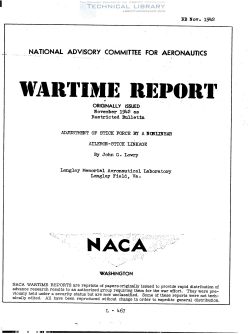naca-wr-l-467
- Version
- 111 Downloads
- 293.42 KB File Size
- 1 File Count
- April 2, 2017 Create Date
- April 2, 2017 Last Updated
Adjustment of Stick Force by a Nonlinear Aileron Stick Linkage

It is a well- known fact that the aileron-stick force
caIn be vari‘ed by changing the medhanical advantage of the
.oontrol system. This_principle is herein applied to an
aileron installation in which the stick forces are small
ever the low-deflectien'range and excessively large at
full deflection. If the stick forces at full deflection
are lowered to desirable values by an increase in the bal-
ancing, moment. the balance at low deflections is very
critical and overbalanoe is probable as a result of struc.
tural irregularities. Reduction of the excessively high
stick forces at full deflection with a nonlinear linkage
dnoroases the stick forces over the lowqdeflectien range
and gives a more nearly linear variation of stick force
with stick deflection. .
Inasmuch as a system that could be determined math-
eImatically rather than by trial and er_ror was desirable.
the subject linkage was based on a sinIe curve. The sys-
tem is shown schematically in figure 1 and the derivation
of the equations for the system is given in the appendix.
The aileronrstick motion and mechanical advantage are
g iven for equal up~ ~and-down deflections by the following
“signations:
‘ I R n .
'3 1 191 _3 _1_
5e e n [as sin (Rs 85)] (l)
31
cos —— 5. n ,
93a 3: El “(33 > (2)
doI as see Ga
for which the radii and angles are shown in figure 1. In
order to obtain any desired mechanical advantage at full
aileron deflection. equations (1) and (2) must be solved
simultaneously. For convenience. it is suggested that 25
be given a value of unity and the values of 31 and E3
found.
The design chart (fig. 8) was constructed as a quick
method for solving the equations. Ibis chart gives the
relationship of 6a and e, .which represents (RI/Ba)6
for various values of as and k. The symbol k is used
d6 3
for -w—3 ‘—i and represents the fraction of (dag/d6.) .
d5 Ba 65:0
for any aileron deflection Ba. then the maximum values
of 6a. 8'. and the desired value of k for full deflec—
tion are known. the values of BL and 33. as well as
_ the relationships between 5a and 6' and between'
dag/d8B and 6'. can be found. The values of B and
as "can be determined from the value of 5a for full de—
flection and the desired value of k. Dividing -6 by 5.
gives the value of 31 because the chart is based'on
ha a 1. By use of the values of 21 and 3:, _the value_
_of dag/d6s is determined. When the values of R; and:
3.5 are known. the values of 5s and dog/dda for partial
aileron deflection can be found. If greater accuracy is-
needed in determining dda/dag. it is recommended that '
this value be computed from equation (2) by use of the val-
ues of R; and 33 from the chart.
By use of the aileron-stick motion as shown in figure
3, the stick forces were computed for a modern fighter ,
airplane and were compared with the computed stick forces
based on a straight—line linkage (fig. 4). The two curves
in figure 4 are based on the same maximum values of Ga
and 83. This comparison shows that the sine differential
decreased the maximum stick force by about 9 pounds.or 35
percent. with only a slight increase in the stick forces
for'small aileron deflections. '
| File | Action |
|---|---|
| naca-wr-l-467 Adjustment of Stick Force by a Nonlinear Aileron Stick Linkage.pdf | Download |

Comment On This Post